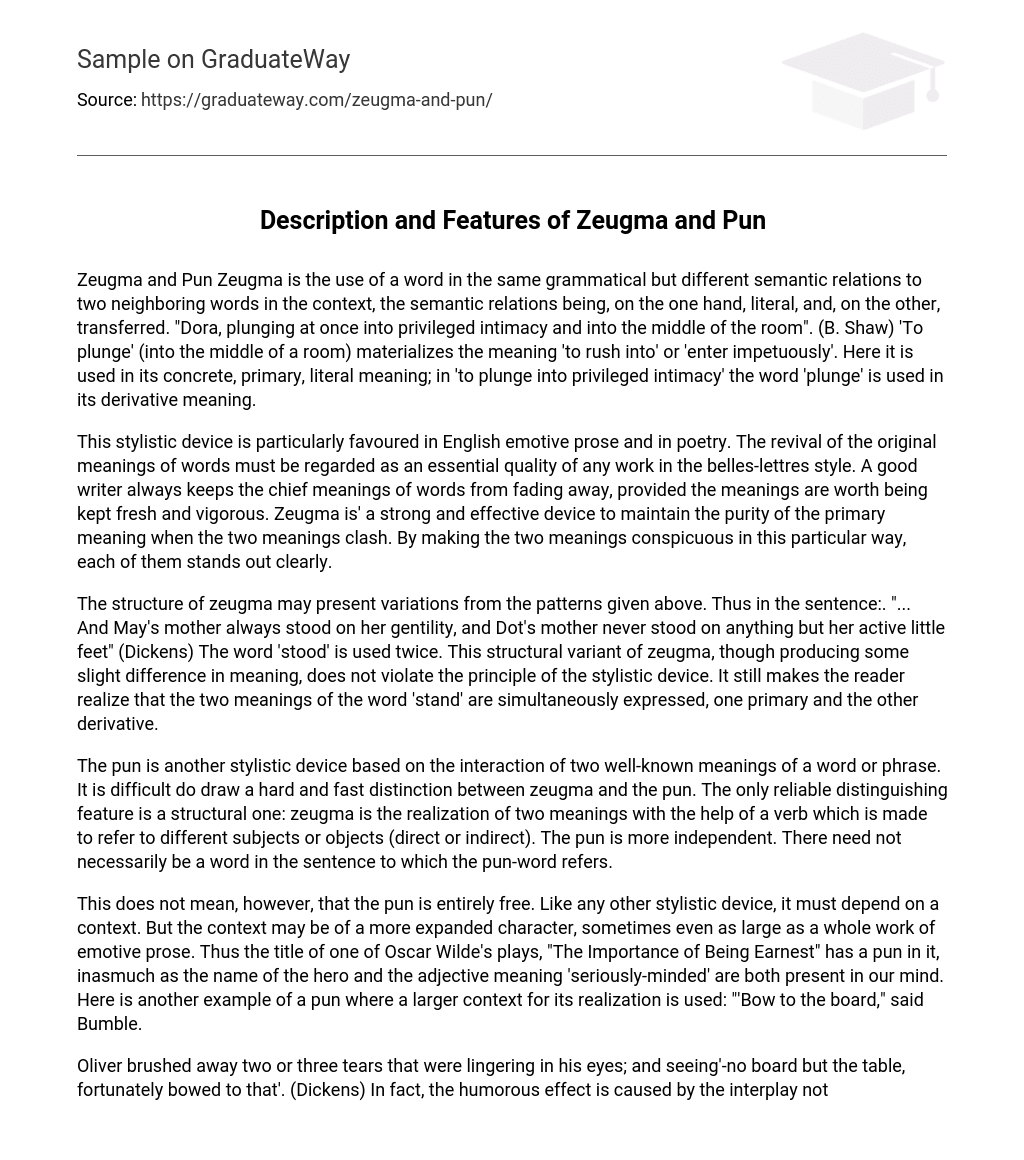Zeugma and Pun Zeugma is the use of a word in the same grammatical but different semantic relations to two neighboring words in the context, the semantic relations being, on the one hand, literal, and, on the other, transferred. “Dora, plunging at once into privileged intimacy and into the middle of the room”. (B. Shaw) ‘To plunge’ (into the middle of a room) materializes the meaning ‘to rush into’ or ‘enter impetuously’. Here it is used in its concrete, primary, literal meaning; in ‘to plunge into privileged intimacy’ the word ‘plunge’ is used in its derivative meaning.
This stylistic device is particularly favoured in English emotive prose and in poetry. The revival of the original meanings of words must be regarded as an essential quality of any work in the belles-lettres style. A good writer always keeps the chief meanings of words from fading away, provided the meanings are worth being kept fresh and vigorous. Zeugma is’ a strong and effective device to maintain the purity of the primary meaning when the two meanings clash. By making the two meanings conspicuous in this particular way, each of them stands out clearly.
The structure of zeugma may present variations from the patterns given above. Thus in the sentence:. “… And May’s mother always stood on her gentility, and Dot’s mother never stood on anything but her active little feet” (Dickens) The word ‘stood’ is used twice. This structural variant of zeugma, though producing some slight difference in meaning, does not violate the principle of the stylistic device. It still makes the reader realize that the two meanings of the word ‘stand’ are simultaneously expressed, one primary and the other derivative.
The pun is another stylistic device based on the interaction of two well-known meanings of a word or phrase. It is difficult do draw a hard and fast distinction between zeugma and the pun. The only reliable distinguishing feature is a structural one: zeugma is the realization of two meanings with the help of a verb which is made to refer to different subjects or objects (direct or indirect). The pun is more independent. There need not necessarily be a word in the sentence to which the pun-word refers.
This does not mean, however, that the pun is entirely free. Like any other stylistic device, it must depend on a context. But the context may be of a more expanded character, sometimes even as large as a whole work of emotive prose. Thus the title of one of Oscar Wilde’s plays, “The Importance of Being Earnest” has a pun in it, inasmuch as the name of the hero and the adjective meaning ‘seriously-minded’ are both present in our mind. Here is another example of a pun where a larger context for its realization is used: “‘Bow to the board,” said Bumble.
Oliver brushed away two or three tears that were lingering in his eyes; and seeing’-no board but the table, fortunately bowed to that’. (Dickens) In fact, the humorous effect is caused by the interplay not of two meanings of one word, but of two words. ‘Board’ as a group of officials with functions of administration and management and ‘board’ as a piece of furniture (a table) have become two distinct words. Puns are often used in riddles and jokes, for example, in this riddle: What is the difference between a schoolmaster and an engine-driver? One trains the mind and the other minds the train. ) Devices of simultaneously realizing the various meanings of words, which are of a more subtle character than those embodied in puns and zeugma, are to be found in poetry and poetical descriptions and in speculations in emotive prose. Men-of-letters are especially sensitive to the nuances of meaning embodied in almost every common word, and to make these words live with their multifarious semantic aspects is the task of a good writer.
Those who can do it easily are said to have talent. In this respect it is worth subjecting to stylistic analysis words ordinarily perceived in their primary meaning but which in poetic diction begin to acquire some additional, contextual meaning. This latter meaning sometimes overshadows the primary meaning and it may, in the course of time, cease to denote the primary meaning, the derived mean-ing establishing itself as the most recognizable one.





